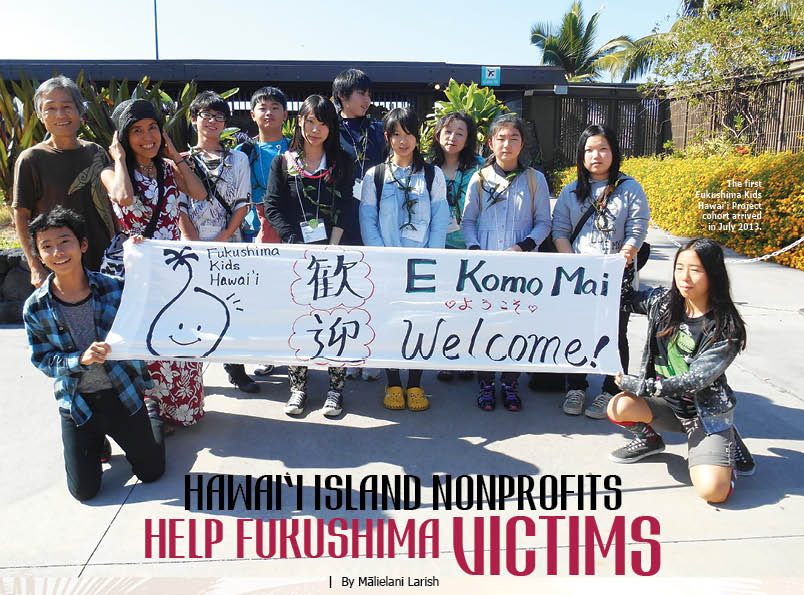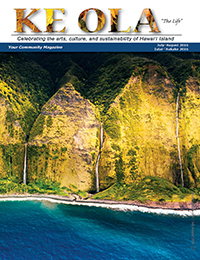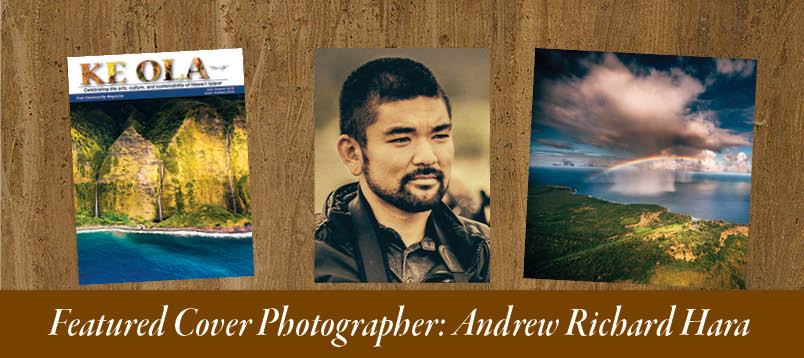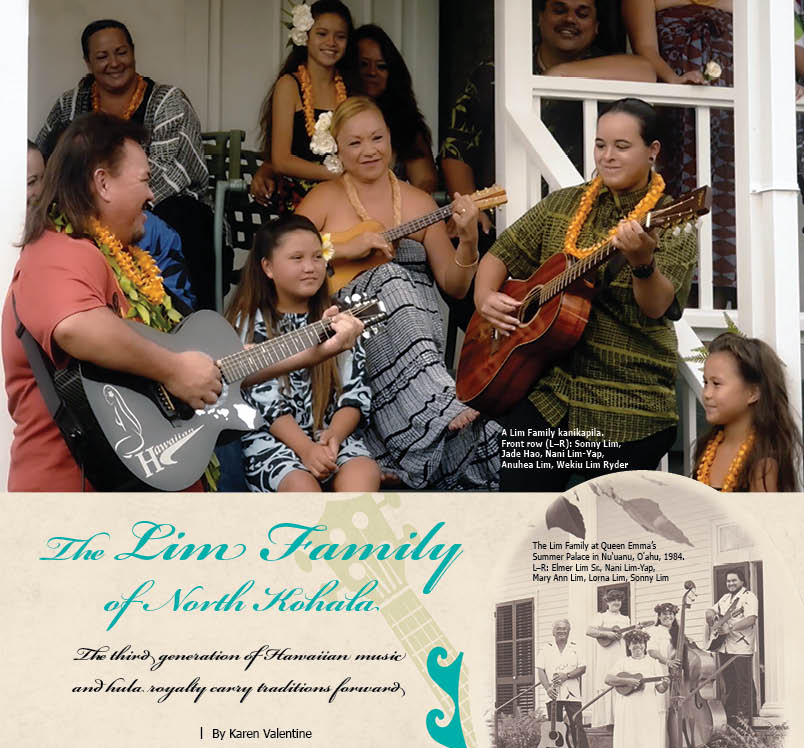
Hawai‘i Island Nonprofits Help Fukushima Victims
By Mālielani Larish
Fukushima Kids Hawai‘i
Standing on a narrow Tōkyō street while the ground beneath her shuddered violently, Yumi Kikuchi looked up at the swaying ancient skyscraper that she had just abandoned. Yumi decided to return to the building, fearing that inside or outside, she would not live to see her children. Fortunately, Yumi and her husband Gen Morita survived Japan’s powerful March 11, 2011 earthquake. Afterwards, they committed themselves to helping the innocent victims of the subsequent nuclear disaster.
That night, while footage of the resulting tsunamis absorbed the nation’s attention, Yumi spied a small news flash on the screen that read “Station Blackout at Fukushima Daiichi.” Her heart started pounding fast; after 20 years of educating herself and others about nuclear power, she knew that Fukushima Daiichi had begun an irreversible meltdown.
Upon finding her family safe in Kamogawa the next day, Yumi and Gen agreed to leave their beloved farm in order to move the family as far away from the impending nuclear crisis as possible.
Fukushima Daiichi’s first nuclear reactor exploded on the following day, covering the Tōkyō area in a plume of radiation. One thousand miles away, Gen, Yumi, and two dear friends were already busy founding Tsunagu Hikari (Connecting Light), an organization that eventually evacuated 264 children and mothers from Fukushima to Okinawa. Babies, children, and pregnant woman are the most susceptible to radiation because of the rapid growth they undergo.
Yumi and Gen continue to help the victims of Fukushima today, albeit in a different setting. You can find them working on laptops at a favorite café with a vista of Kailua-Kona’s sparkling blue waters. With calm, welcoming eyes and steady authority, Gen explains that his work for an environmental nonprofit first brought him to Hawai‘i in the 1980s, and that his family has spent every winter in the islands since then.

Bright-eyed, cheerful, and full of fresh energy, Yumi recalls that they had already booked a trip to Hawai‘i before the earthquake occurred. After deciding to move to Kona permanently, Yumi and Gen founded Fukushima Kids Hawai‘i, a nonprofit that provides the children and mothers of Fukushima with a healthy respite period in the islands.
Fukushima Kids Hawai‘i runs two distinct projects: an educational program, Fukushima Kids Hawai‘i Project, for middle and high school students that coincides with their summer and winter holidays, and Fukushima Kids Hawai‘i House, a shelter near Kailua-Kona where mothers and their preschool-aged children can stay for up to three months. Thus far, they have hosted 90 mothers and children from Fukushima.
“We want to give them a healthier, healing, nurturing environment,” Yumi affirms.
The Fukushima Kids Hawai‘i Project program boosts the children’s immunity with fresh, local, organic meals, and plenty of physical activity. Trained as a macrobiotic and raw food chef, Yumi teaches the kids gardening, cooking, and the value of farm-to-table eating. The group spends three days detoxing at natural steam rooms in Pāhoa at a retreat center named the Kingdom of Heaven.
As a practitioner of traditional Japanese medicine and other healing modalities, Gen educates the kids about health maintenance. The program addresses psychological health too; Yumi leads classes on the Connection Practice, a scientifically-based social-emotional skill developed by peace activist Rita Marie Johnson.
Special guest teachers and excursions enliven the month-long program. Past groups have enjoyed canoe paddling, hiking, dolphin tours, concerts, and a night of sharing Japanese songs with the community. Fukushima Kids Hawai‘i Project hosted the first program cohort in July 2013 with six students ranging in age from 11-17 years old.
Yumi and Gen have witnessed remarkable recoveries in some of the youngsters, such as kids showing up for the program with cysts and leaving without them. Medical studies on the children impacted by Chernobyl confirm that respite periods can benefit children’s health. One of the girls who will attend the upcoming summer 2016 program says that she would like to learn healing tools to bring back to her mother in Fukushima, who is a nurse that cared for the tsunami victims and later developed cancer.
The respite period facilitates mental renewal for the mothers, many of whom arrive scared and confused. Yumi remembers one mother who never allowed her children to touch soil, insects, or flowers in Fukushima due to a fear of radiation. When she witnessed her children touching the earth in Hawai‘i for the first time, she burst into tears and confided, “I don’t have to say that anymore!”
Foreshadowing the future consequences for Fukushima, the radiation at Chernobyl has had a lasting impact on the health of residents who live in the contaminated area. The rate of thyroid cancer, which is directly linked to nuclear radiation, is already 20 to 50 times higher in the children of Fukushima than Japan’s national average, mirroring a similar spike in thyroid cancer cases after the Chernobyl accident.
Fukushima Kids Hawai‘i is completely run by volunteers. Yumi and Gen pay for the initial airfare of participants and recover the cost later through fundraisers, which have ranged from classical concerts to Zumbathon® and garage sales.
Hundreds of community members have donated time, space, and money to the program, and Yumi wishes that she could extend her personal thanks to each of them. Yumi and Gen are especially grateful for four major supporters of the program: Ho‘olokahi Congregational Church, which donates on a regular basis;
Mayumi Oda of Ginger Hill Farm, who provides an abundance of fresh, organic produce; the Kingdom of Heaven retreat center, which has hosted many of the program’s guests; and Henk and Akemi Rogers, the couple who established the ALOHA-KEIKI nonprofit that Fukushima Kids Hawai‘i operates under.
Embodying the abundant love of Mother Earth, Yumi says “If I could, I would be the mother for all the kids, but I don’t have the resources. I wish I could move all the kids here.”
Exemplifying the protective spirit of the father, Gen says “People are forgetting now, but the situation is still the same. Nuclear contamination does not disappear. That’s why healing and health maintenance and teaching the next generation is essential.”
Fukushima Friends Hawai‘i Bible Camp
“Can you bring flowers from Hawai‘i over to cheer people up?” After waiting nine months to hear how she could help the Fukushima victims, Vicki Nelson was delighted to receive this message from a friend in Japan who was organizing a fun community event for the people of Fukushima.
Around Christmas of 2011, Vicki landed in Japan with an array of anthuriums and ginger blossoms from Hawai‘i. Vicki is the president of Puna Kamali‘i Flowers, a business in Kea‘au that trains and employs people with developmental disabilities. She first visited Japan in order to share her expertise in this business niche at a conference.
Before her arrival, Vicki wondered why people did not choose to abandon the nuclear danger zone, and she quickly learned that many factors prevent residents from leaving.
First, she learned that the Japanese people have always succeeded in rebuilding after a tragedy. Powerful tidal waves similar to the March 11, 2011 tsunamis have damaged the north-eastern coast of Honshū Island in the past.
Secondly, the government actively encourages people to stay.
Finally, the prime agricultural land and abundant fishing grounds in the Fukushima area make residents reluctant to forsake their time-honored livelihoods.
Vicki and her friend spent 10 days visiting people with disabilities in Fukushima, showing them photos of Hawai‘i, making lei, and letting them know that Vicki would open her home in Hawai‘i for anyone seeking respite.
As Vicki fell in love with Fukushima’s beautiful harbors, stately pine trees, and snow-capped peaks, she developed sore eyes and throat, stinging skin, and bumps on her forehead. During the five-hour car trip from Fukushima back to Narita Airport, she could feel when she had escaped from the radiation bubble, for these eerie symptoms vanished.
A few months later, the first group of Fukushima residents arrived at Vicki’s own three-bedroom home in Kea‘au. Many of the guests have developmental disabilities; however, this is not a prerequisite for staying with Vicki. Some of the guests are simply mothers seeking to keep their kids safe and healthy.
“When people come, the children have been very sick, and some of the adults have been very sick,” Vicki says.
They enter her home with cysts, nosebleeds, vomiting, diarrhea, dizziness, ashen faces, and other symptoms. Many of the symptoms clear up after just two weeks of being in Hawai‘i.
Vicki recalls hosting a mother whose daughters (ages 4 and 6) were kept indoors and not allowed to touch anything in Fukushima. When they arrived in Hawai‘i, they suffered from nosebleeds and shied away from human touch. After a few weeks, they were running, jumping, riding bicycles, and sitting on her husband’s lap. Positive stories like this one motivate Vicki to continue assisting the Fukushima victims.
Because there is so much unresolved trauma in Fukushima, Vicki is working with a hui (partnership) to build a permanent respite home in Hawai‘i.
“When you are away from your problems, maybe you can more clearly look at them and envision if there is a possibility to change your life and find a place of rest and reflection,” Vicki says.
Guests pay for their own airfare, and Vicki provides them with food, tours of the island, and daily Bible study. Her Facebook page, Fukushima Friends Hawai‘i Bible Camp, states that each participant is “embraced.”
Vicki’s own church and churches on O‘ahu and the mainland have answered her prayers for monetary donations, which help cover the cost of gas and food for program guests.
Little miracles have helped. When Vicki was expecting another group from Fukushima, and had zero time to fundraise for their stay, a friend in Hilo announced that he was closing down a business and that she could sell everything in the office for a fundraiser. Surprised and grateful, Vicki moved and sold thousands of dollars worth of office equipment with the help of her employees and Craigslist.
Vicki realizes that people do not understand the magnitude of Fukushima’s suffering, describing it as “trauma beyond our imagination.” When she asks people to help with volunteering or fundraising, many people say “What’s the problem in Fukushima?” With nuclear radiation, the problem will endure for thousands of years.
Although Vicki acknowledges the challenges of juggling work, family, and helping the people of Fukushima, her secret is simple: “We just take one day at a time and trust that God is taking care of us.” ❖
Contact Fukushima Kids Hawai‘i, email
Contact Fukushima Friends Hawai‘i Bible Camp
Photos courtesy Fukushima Kids Hawai‘i and Fukushima Friends Hawai‘i Bible Camp.
Contact writer Mālielani Larish
References
Ecological Options Network. “Fukushima Up Close and Personal: Yumi Kikuchi.” YouTube video, 53:19. Mar. 1, 2012.
ENE News. “Fukushima: Hawaii-Based Nonprofit Group Says ‘Every Single Person’ They Hosted from Japan Has Had Health Problems.” June 29, 2015.
Jacob, P. et al. Thyroid Cancer in Ukraine and Belarus after the Chernobyl Accident: Baseline and Total Incidence.
The Japan Times. “New report links thyroid cancer rise to Fukushima nuclear crisis.” Oct. 7, 2015.
Lilou Mace TV. Japan’s Radiations, ETs, and Life Force: Gen Morita. YouTube video, 46:58. June 29, 2011.



